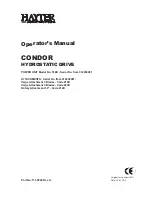
34
35
Controllare che la leva di bloccaggio sia nella
posizione corretta
Portare la leva dello starter in posizione
"CHIUSA"
Controllare se il rubinetto del carburante è
aperto.
Se è chiuso, aprirlo.
Controllare il livello del carburante.
Se è vuoto, rabboccare il carburante.
Attenzione a non riempire troppo
Verificare che l'interruttore del motore sia in
posizione "OFF".
Portare l'interruttore del motore in posizione
"ON"
Verificare che il generatore non sia collegato
a un apparecchio.
Se è collegato a un apparecchio, spegnere
l'interruttore di alimentazione
dell'apparecchio e staccare la spina.
Controllare la candela nel caso in cui il
cappuccio della candela sia allentato.
Se è allentato, spingere nuovamente il
cappuccio della candela sulla candela stessa.
Controllare che la candela non abbia accumuli
di carbonio.
Rimuovere la candela e pulire l'elettrodo o
sostituire la candela con una nuova.
1. GENERAL SAFETY PRECAUTIONS:
Danger
Warning
Caution
1.1. A "LAYMAN” and or “CHILDREN” may not
recognize the possible dangers of operating
a generator. We recommend that only
competent person should operate the
generator.
1.2. Fuel is combustible and easily ignited.
Do not refuel during operation.
1.3. Do not refuel whilst smoking or near
naked flames. Do not overfill or spill fuel. If
this happens, clean the fuel on and around
the generator properly before operating.
1.4. Only use the specified fuel when
operating the generator
1.5. Some parts of the internal-combustion
engine are hot and might cause burns. Pay
attention to the warning signs on the
generating set.
1.6. Engine exhaust gases are toxic. Do not
operate the generator in an unventilated
room. When installed in a ventilated room,
additional requirements for fire and explo-
sion protection must be observed.
1.7. Regularly check that the bolts and nuts
are properly tightened as they may become
loose due to vibration of the generator whilst
in use.
1.8. Before using the generator ensure that
you have checked the periodic maintenance
schedule in the operator's manual.
1.9. Pay attention to the wiring or extension
cords from the generator to the connected
device. If the wire is under the generator or in
contact with a vibrating part, it may break
and possibly cause a fire, generator burnout,
or electric shock hazard. Replace damaged or
worn cords immediately.
1.10. Do not operate in rain, wet or damp
conditions, or with wet hands. The operator
may suffer severe electric shock if the
generator is wet.
1.11. If wet, wipe and dry it well before
starting. Do not pour water directly over the
generator, nor was hit with water.
1.12. Be extremely careful that all necessary
electrical grounding procedures are followed
during each and every use. Failure to do so
can be fatal.
1.13. Do not connect the generator to a
commercial power line. Connecting to a
commercial power line may short circuit the
generator. We strongly recommend the use
of a Transfer Switch for connecting to a
domestic circuit.
1.14. Do not smoke when handling the
battery. The battery emits flammable
hydrogen gas, which can explode if exposed
to cigarettes and or naked flames. Keep the
area well-ventilated and keep naked flames/
sparks away when handling the battery.
1.15. Keep children and all bystanders at a
safe distance from the generator whilst in
use.
1.16. It is absolutely essential that you know
and understand the safe and proper use of
the power tool or appliance that you intend
to connect to the generator. All operators
must read, understand and follow the
tool/appliance operator’s manual. The tool
and appliance applications and
1.17. Always switch off the circuit breaker on
the generator when not in use.
Verificare che l'interruttore automatico sia in
posizione "ON".
Dopo essersi assicurati che la potenza totale
dell'apparecchio elettrico rientri nei limiti
consentiti e che non vi siano difetti negli
apparecchi, portare l'interruttore automatico
in posizione "ON". Se gli interruttori
continuano
a
scattare,
contattare
il
rivenditore.
Verificare che i terminali CA e CC non siano
allentati.
Se necessario, fissare il collegamento.
Controllare se un apparecchio è collegato
mentre si cerca di avviare il generatore.
Spegnere l'interruttore dell'apparecchio e
scollegare il cavo/la spina dell'apparecchio
dalla presa. Ricollegare solo dopo che il
generatore si è avviato e funziona
regolarmente.
Potenza in uscita bassa o irregolare dal
generatore.
Controllare se le spazzole di carbone sono
eccessivamente usurate e, se necessario,
sostituirle.
2. ELECTRICAL SAFETY PRECAUTIONS:
2.1. Electrical equipment including cable, cords and plug connection must not be
defective. Please check before using.
2.2. Do not plug the generator directly into a wall socket-outlet.
2.3. The generator should not be connected to other sources such as the power
company supply mains. In special cases where stand-by connection to existing electrical
systems or integration therewith is intended, note that it is a legal requirement that such
connections or integration may only be performed by a competent person.
2.4. Protection against electrical shock depends on circuit-breakers that are specially
matched to the generator. If a circuit breaker requires replacement, it shall be replaced
by a circuit breaker that has identical ratings and performance characteristics.
2.5. Due to high mechanical stress, only tough rubber-sheathed flexible cable should be
used.
2.6. If the generator is of CLASS II construction, then earth of the generator is not
required.
2.7. Cord Extension Sets:
2.7.1. A 1mm2 flexible cable can draw a maximum of 10A provided that the cable is
not longer than 25m.
2.7.2. A 1.5mm2 flexible cable can draw a maximum of 10A provided that the cable is
not longer than 35m.
2.7.3. A 1.5mm2 flexible cable can draw a maximum of 16A provided that the cable is
not longer than 20m.
2.7.4. A 2.5mm2 flexible cable can draw a maximum of 10A provided the cable is not
longer than 65m.
2.7.5. A 2.5mm2 flexible cable can draw a maximum of 16A provided that the cable is
not longer than 45m.
2.7.6. A 4mm2 flexible cable can draw a maximum of 10A provided that the cable is
not longer than 100m .
2.7.7. A 4mm2 flexible cable can draw a maximum of 16A provided that the cable is
not longer than 65m.
















































